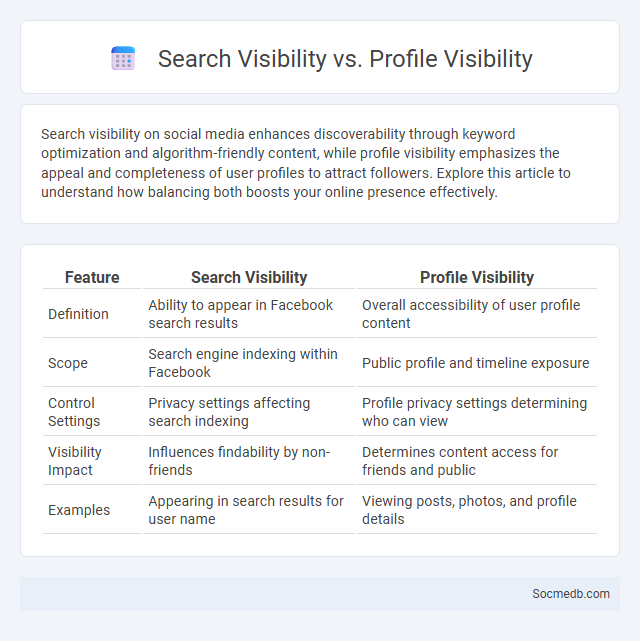
Photo illustration: Search Visibility vs Profile Visibility
Search visibility on social media enhances discoverability through keyword optimization and algorithm-friendly content, while profile visibility emphasizes the appeal and completeness of user profiles to attract followers. Explore this article to understand how balancing both boosts your online presence effectively.
Table of Comparison
| Feature | Search Visibility | Profile Visibility |
|---|---|---|
| Definition | Ability to appear in Facebook search results | Overall accessibility of user profile content |
| Scope | Search engine indexing within Facebook | Public profile and timeline exposure |
| Control Settings | Privacy settings affecting search indexing | Profile privacy settings determining who can view |
| Visibility Impact | Influences findability by non-friends | Determines content access for friends and public |
| Examples | Appearing in search results for user name | Viewing posts, photos, and profile details |
Introduction to Search Visibility, Profile Visibility, and Privacy Settings
Social media platforms enhance your search visibility by optimizing profiles with relevant keywords and content that appear in search engine results, increasing the chances of being discovered. Profile visibility settings control who can view your information, posts, and activity, allowing you to tailor your online presence for different audiences. Privacy settings are essential to protect your personal data, enabling you to manage permissions, control data sharing, and maintain security across your social media accounts.
Defining Search Visibility: What It Means for Users
Search visibility on social media refers to how easily users can discover content through platform search functions, hashtags, and algorithms prioritizing relevance. High search visibility increases the likelihood that posts, profiles, and brands appear in user searches, enhancing engagement and reach. Factors influencing visibility include keyword optimization, content quality, and user interaction metrics such as likes, shares, and comments.
Understanding Profile Visibility: Who Can See Your Profile
Profile visibility on social media platforms varies based on privacy settings, determining who can access your personal information, posts, and contact details. Users can usually customize visibility options to restrict access to friends, followers, or make profiles fully public for broader reach. Understanding these settings helps protect privacy, control online presence, and manage interactions effectively.
Exploring Privacy Settings: Controlling Your Online Presence
Exploring privacy settings on social media platforms allows users to manage who can view their profiles, posts, and personal information, significantly enhancing online security. By customizing options such as friend lists, activity visibility, and data sharing preferences, individuals gain greater control over their digital footprint. Regularly reviewing and updating these settings helps prevent unauthorized access and protects against data breaches or identity theft.
Key Differences Between Search Visibility and Profile Visibility
Search visibility refers to how easily content or profiles appear in search engine results based on keywords, algorithms, and SEO optimization, while profile visibility focuses on the exposure and accessibility of an individual or brand's social media profile within the platform itself. Search visibility is influenced by factors such as metadata, backlinks, and keyword relevance, whereas profile visibility depends on user interactions, follower count, and platform-specific algorithms like engagement rate and posting frequency. Understanding these distinctions helps optimize both organic search traffic and direct social media audience engagement effectively.
How Privacy Settings Impact Your Search and Profile Visibility
Adjusting your social media privacy settings directly influences your searchability and profile visibility, controlling who can find and view your information. By customizing settings such as profile visibility, post sharing options, and search engine indexing preferences, you can limit unwanted exposure and protect personal data. Understanding these controls enhances your online privacy and ensures that your presence aligns with your desired level of accessibility on social platforms.
Benefits of Customizing Search and Profile Visibility
Customizing search settings on social media platforms enhances content relevance by filtering out unwanted topics and prioritizing preferred interests, leading to a more personalized user experience. Adjusting profile visibility controls who can access personal information, increasing privacy and security while allowing users to manage their online presence effectively. These features empower users to curate their digital interactions, fostering safer and more meaningful connections.
Risks of Mismanaging Visibility and Privacy Settings
Mismanaging visibility and privacy settings on social media exposes personal data to unauthorized access, increasing the risk of identity theft and cyberbullying. Inadequate control over profile visibility can lead to oversharing, making sensitive information easily accessible to malicious actors. Users must regularly review and update privacy configurations to safeguard digital footprints and maintain online security.
Best Practices for Managing Online Visibility and Privacy
Effective management of online visibility and privacy on social media platforms involves regularly updating privacy settings to control who can access personal information and posts. Utilizing strong, unique passwords combined with two-factor authentication enhances account security against unauthorized access. Being mindful of the content shared, avoiding oversharing, and conducting periodic audits of tagged photos and public posts help maintain a positive digital footprint and protect personal data.
Conclusion: Balancing Visibility with Privacy Online
Maintaining a balance between visibility and privacy on social media requires strategic management of personal data and privacy settings. Users must critically evaluate what information they share to safeguard against identity theft and data misuse. Effective privacy controls and mindful content sharing enhance online presence while protecting individual security.
 socmedb.com
socmedb.com